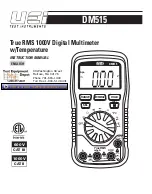Channel Port (Left and Right)
The Channel Ports transmit and receive signals on a specific CWDM wavelength.
The Channel Ports are multiplexed on and demultiplexed from the Common Ports.
As shown in Figure 3 and 4, a 1-Channel CWDM/AD supports a single channel in
both directions and a 2-Channel CWDM/AD supports two channels in both directions.
Each Channel Port has a Left and Right port. Data transmitted and received by
Channel Port Left is aggregated on Common Port Left and data transmitted and
received by Channel Port Right is aggregated on Common Port Right.
CWDM / AD
2 - 4
CWDM/X
1
2
3
4
CWDM/X
1
2
3
4
1
(Left)
1
(Right)
COM-L
COM-R
Figure 3: 1-Channel Add/Drop MUX/DEMUX
COM-L
COM-R
CWDM / AD
1
(Left)
1
(Right)
3 - 4
CWDM/X
1
2
3
4
CWDM/X
1
2
3
4
2
(Left)
2
(Right)
Figure 4: 2-Channel Add/Drop MUX/DEMUX
NOTE: For more information on the
iConverter
CWDM/X modules, visit Omnitron’s
website at: http://www.omnitron-systems.com
Common Port (Left and Right)
The Common Ports transmit and receive the aggregated wavelengths connected to
the Channel Ports. As shown in Figures 3 and 4, there are Left and Right Common
Ports on the CWDM/AD module. Common Port Left (COM-L) and Common Port
Right (COM-R) are internally connected to pass through all wavelengths not dropped
or added by the specific CWDM/AD model. Only the specific wavelength of the
model selected will be dropped to the appropriate Channel Port. Common Port
Left drops and adds wavelength traffic from Channel Port Left and Common Port
Right drops and adds wavelength traffic from Channel Port Right.
Page 2
Installation
1. Carefully slide the module into an open slot in an
iConverter
chassis. Align
the module with the installation guides and ensure that the module is firmly
seated against the backplane. Secure the module by fastening the front panel
thumbscrew (push in and turn clockwise to tighten) to the chassis front. The
CWDM/AD module requires no external power, however, if management is
required, the module must be installed in an
iConverter
powered chassis with
a Network Management Module (NMM2 Model 8000N-0) or a media converter
with integrated management (such as the
iConverter
10/100M2)*.
2. Connect a single-mode, dual fiber duplex LC cable between the Channel Port of
the CWDM/AD module and the attached device. It is important to ensure that the
wavelength of the CWDM/AD matches the wavelength of the attached device.
When connecting the Channel Port, make sure the Left/Right designation is
followed. This will ensure the data from the Channel Port is aggregated onto the
corresponding Common Port. Ensure that the transmit (Tx) is attached to the
receive side of the device at the other end, and the receive (Rx) is attached to
the transmit side.
3. Connect a single-mode, dual fiber duplex LC cable between the Common
Ports on the CWDM/AD module(s) (this connection may be made through fiber
patch panels since the modules may not be co-located) or CWDM/X devices.
When connecting between the Common Ports on the CWDM/AD modules, it
is recommended to connect the Common Port Right (COM-R) to the Common
Port Left (COM-L) on the other CWDM/AD module. Ensure that the transmit
(Tx) is attached to the receive side of the device at the other end, and the
receive (Rx) is attached to the transmit side.
NOTE: For proper installation, a network diagram indicating port designations is
recommended.
NOTE: The
iConverter
CWDM/AD modules can not be installed in slots 4, 8, 12 and
16 of a 19-Module Chassis or in the top slot of a 2-Module Chassis or in a 1-Module
Redundant Power Chassis.
*For complete management functionality, use M2 series (NMM2, GX/TM2, 2GXM2.
10/100M2, 2FXM2) or higher.
Design Considerations
iConverter
CWDM/AD modules are passive devices that require no external power.
Attenuation (signal loss) of less than 1.9dB will be realized through each port on the
module (see the CWDM/AD Data Sheet for exact loss specification for each model).
Detailed calculations should be performed for each fiber optic link in the network to
ensure the proper optical devices are specified with sufficient transmitter power.
When calculating optical loss, ensure that the total loss, plus a safety factor (typically
3dB), does not exceed the optical power budget. The optical power budget is the
difference between the transmitter optical output power and the receiver’s optical
sensitivity.
Page 3


















